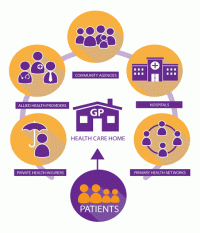Latest news

Patient Centred Medical Home (Health Care Homes)
There has been increased talk around the implementation of the Patient Centred Medical Home (PCMH) in General Practice or Primary Health Care Services. The PCMH model is often referred to as Patient Centred Health Care Home (PCHCH) in Australia.
The PCMH has been the basis of significant reform in the US primary health care model over the past decade. This model of care stresses putting the patient-provider relationship at the core of all healthcare decision making and ensures data-driven comprehensive care is provided to improve patient outcomes and experience. In order to support the entirety of a patient’s primary care needs, a provider develops a team-based approach to healthcare with an emphasis on preventative services, safety and quality, care coordination, and enhanced access to care.

The key principles of the PCMH are:
- Taking a patient-centred approach to care delivery by developing meaningful relationships with the patient, their family, and caregivers that takes into account the patient’s socioeconomic and cultural values and preferences;
- Providing comprehensive care by taking into account the patient as a whole person and supporting both mental and physical health with a coordinated care team;
- Enhanced coordinated care for patients as they move across the healthcare system, harnessing health information exchange, EHR interoperability, and population health management analytics to ensure that patient health information is accessible and usable at all care sites across the healthcare continuum;
- Ensuring the accessibility of services by offering extended hours, alternative sites for care during emergencies, improving the scheduling process, or through the use of technology.
- Focusing on care quality and patient safety by using evidence-based medicine, clinical decision support tools, healthcare analytics, and best practices to provide a safe, high-quality, satisfactory experience for each and every patient.
Over the past decade, the adoption of this model has resulted in improved management of complex chronic disease, enhanced access to high-quality care, reduced hospitalisation, re-admissions and an overall reduction in care costs.
The Patient Centred Health Care Home (PCHCH) in Australia has gained the support of key medical groups, including the Australian Medical Association (AMA) and the Royal Australian College of General Practitioners (RACGP), Government, Primary Health Networks (PHNs), consumer groups and clinicians, as a model that can transform Australian primary care to deliver improved coordinated care services, enhance population outcomes and experience, and reduce per capita costs of care.
AGPAL is actively working with the Government, the PHNs nationally, influential professional organisations, clinicians, consumers, national and international experts, and other key stakeholders to develop resources, education and training material, standards and an outcome-based accreditation for the PCHCH.
Source: Article extracted from AGPAL’s Quality News magazine, Winter 2016 edition.
Is your practice interested in becoming a Health Care Home? Expressions of Interest opening soon.
In anticipation of the launch of the Health Care Homes, health care providers – General Practices and Aboriginal Medical Services will soon be able to submit their Expression of Interest to become a Health Care Home.
On 24 August 2016, the Government announced the initial ten geographical regions which will see the first roll-out of Health Care Homes. These regions lie within the following Primary Health Network (PHN) boundaries:
- Perth North PHN
- Adelaide PHN
- Country South Australia PHN
- Brisbane North PHN
- Western Sydney PHN
- Hunter New England and Central Coast PHN
- South Eastern Melbourne PHN
- Nepean Blue Mountains PHN
- Northern Territory PHN
- Tasmania PHN
The Department of Health will open the Expressions of Interest from late 2016 from within these areas (stage 1) and will release further information closer to this time. Keep your eye out for updates via AGPAL’s communication channels and through the Department of Health’s website – www.health.gov.au



